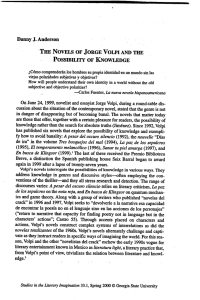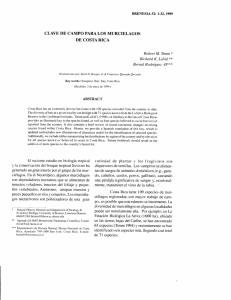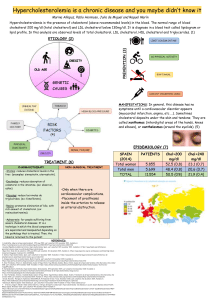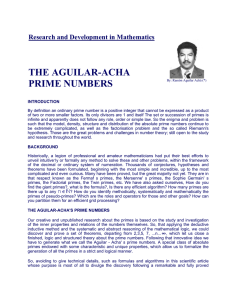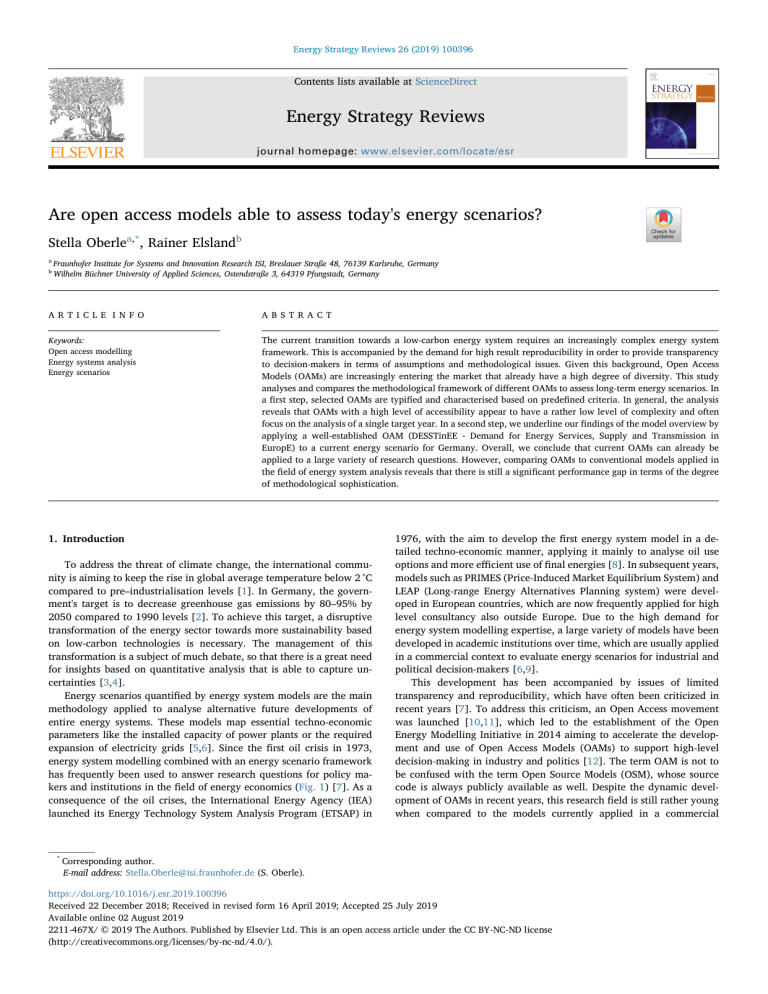
Energy Strategy Reviews 26 (2019) 100396 Contents lists available at ScienceDirect Energy Strategy Reviews journal homepage: www.elsevier.com/locate/esr Are open access models able to assess today's energy scenarios? a,* Stella Oberle , Rainer Elsland a b T b Fraunhofer Institute for Systems and Innovation Research ISI, Breslauer Straße 48, 76139 Karlsruhe, Germany Wilhelm Büchner University of Applied Sciences, Ostendstraße 3, 64319 Pfungstadt, Germany A R T I C LE I N FO A B S T R A C T Keywords: Open access modelling Energy systems analysis Energy scenarios The current transition towards a low-carbon energy system requires an increasingly complex energy system framework. This is accompanied by the demand for high result reproducibility in order to provide transparency to decision-makers in terms of assumptions and methodological issues. Given this background, Open Access Models (OAMs) are increasingly entering the market that already have a high degree of diversity. This study analyses and compares the methodological framework of different OAMs to assess long-term energy scenarios. In a first step, selected OAMs are typified and characterised based on predefined criteria. In general, the analysis reveals that OAMs with a high level of accessibility appear to have a rather low level of complexity and often focus on the analysis of a single target year. In a second step, we underline our findings of the model overview by applying a well-established OAM (DESSTinEE - Demand for Energy Services, Supply and Transmission in EuropE) to a current energy scenario for Germany. Overall, we conclude that current OAMs can already be applied to a large variety of research questions. However, comparing OAMs to conventional models applied in the field of energy system analysis reveals that there is still a significant performance gap in terms of the degree of methodological sophistication. 1. Introduction To address the threat of climate change, the international community is aiming to keep the rise in global average temperature below 2 °C compared to pre–industrialisation levels [1]. In Germany, the government's target is to decrease greenhouse gas emissions by 80–95% by 2050 compared to 1990 levels [2]. To achieve this target, a disruptive transformation of the energy sector towards more sustainability based on low-carbon technologies is necessary. The management of this transformation is a subject of much debate, so that there is a great need for insights based on quantitative analysis that is able to capture uncertainties [3,4]. Energy scenarios quantified by energy system models are the main methodology applied to analyse alternative future developments of entire energy systems. These models map essential techno-economic parameters like the installed capacity of power plants or the required expansion of electricity grids [5,6]. Since the first oil crisis in 1973, energy system modelling combined with an energy scenario framework has frequently been used to answer research questions for policy makers and institutions in the field of energy economics (Fig. 1) [7]. As a consequence of the oil crises, the International Energy Agency (IEA) launched its Energy Technology System Analysis Program (ETSAP) in * 1976, with the aim to develop the first energy system model in a detailed techno-economic manner, applying it mainly to analyse oil use options and more efficient use of final energies [8]. In subsequent years, models such as PRIMES (Price-Induced Market Equilibrium System) and LEAP (Long-range Energy Alternatives Planning system) were developed in European countries, which are now frequently applied for high level consultancy also outside Europe. Due to the high demand for energy system modelling expertise, a large variety of models have been developed in academic institutions over time, which are usually applied in a commercial context to evaluate energy scenarios for industrial and political decision-makers [6,9]. This development has been accompanied by issues of limited transparency and reproducibility, which have often been criticized in recent years [7]. To address this criticism, an Open Access movement was launched [10,11], which led to the establishment of the Open Energy Modelling Initiative in 2014 aiming to accelerate the development and use of Open Access Models (OAMs) to support high-level decision-making in industry and politics [12]. The term OAM is not to be confused with the term Open Source Models (OSM), whose source code is always publicly available as well. Despite the dynamic development of OAMs in recent years, this research field is still rather young when compared to the models currently applied in a commercial Corresponding author. E-mail address: Stella.Oberle@isi.fraunhofer.de (S. Oberle). https://doi.org/10.1016/j.esr.2019.100396 Received 22 December 2018; Received in revised form 16 April 2019; Accepted 25 July 2019 Available online 02 August 2019 2211-467X/ © 2019 The Authors. Published by Elsevier Ltd. This is an open access article under the CC BY-NC-ND license (http://creativecommons.org/licenses/by-nc-nd/4.0/). Energy Strategy Reviews 26 (2019) 100396 S. Oberle and R. Elsland Fig. 1. Cornerstones in the development of energy system modelling (own illustration based on [7,8,12–15]). developing countries. Furthermore, the analysis distinguishes modelling approaches, meaning the way in which the reality is broken down to a model. There are different ways of approaching the modelling process of a system, namely top-down, bottom-up or hybrid. The top-down approach views the system from an aggregated level ‘from the top’ and disaggregates from there. Typical top-down models include input-output models, general-equilibrium models and macro-econometric models. Bottom-up models, on the other hand, describe a system from the bottom to the top, using a technological perspective with a process-technological structure. This means that they start with disaggregated data and aggregate them, finally arriving at the overall system at the end. Models using the bottom-up approach can be classified into accounting models, simulation models and optimisation models. With increasing system complexity, these two modelling approaches are often combined to obtain a more realistic outcome. These combined models are called ‘hybrid models’ [19,26–28,46]. As indicated in Fig. 2, the analysis revealed that models with the highest level of accessibility tend to be simulation models. In contrast, all of the OA frameworks apply the optimisation method. OAMs needing additional software are also mainly optimisation models, while capturing some elements of the simulation method. It should be noted that the results are determined by the model selection. The conclusions may vary when analysing a different set of models. In addition, the models listed in Fig. 2 can be characterised using different criteria, which are mainly identified in the ‘transparency checklist’ of Cao et al. [29]. For instance, temporal granularity has strong impacts on modelling results. There is a general distinction between the analyses of transformation paths (where technological trajectories can be traced back to specific drivers) versus the analysis of a single target year (when a certain configuration is analysed with a limited consideration of path dependencies). Furthermore, temporal granularity can vary within the analysed years from time slices on an hourly basis to a single value for the entire year. Based on these distinctions, the OAMs can be systemised and compared as illustrated in Fig. 3. The comparison shows that there are three OAMs analysing transformation paths, even with hourly time slices. When taking into account the level of accessibility as well, only one model has implemented transformation paths, namely RETScreen [30], which models a number of years to illustrate a development over time. Most of the OAMs with the highest level of openness analyse one year with hourly time slices. OAMs can also be distinguished by their geographical coverage, ranging from low (local/cities), through medium (one country), to high (world/continents), and their sectoral coverage, which can be only one sector or multiple sectors. This comparison is illustrated in Fig. 4 and shows high diversity even within the different groups of accessibility. When looking only at the highest level of accessibility, it becomes clear context. The objective of this study is to analyse whether current OAMs have the analytical depth to assess today's energy scenarios. To do so, we provide an overview of existing OAMs used for energy system analysis. In a first step, the models will be typified to show that they have different degrees of accessibility. Subsequently, these models are characterised according to predefined criteria like their level of endogenisation or their temporal boundaries (chapter 2). In a second step, an exemplary application of a selected OAM is conducted, in which an energy scenario for Germany with high political relevance is reproduced. Selected parameters of the scenario results generated by the OAM are compared to the original study using quality criteria (chapter 3). Finally, conclusions are drawn regarding the status quo of OAMs compared to conventional energy system models currently applied in the field of energy system analysis (chapter 4). 2. Analysis and evaluation of open access models This chapter presents the fundamental findings of an analysis of 40 OAMs. Besides the model manuals, we also considered existing review studies like Connolly et al. [16] or Hall et al. [17]. First, the models investigated were grouped according to their level of accessibility (typification) [18]. Second, the methodologies of the models were analysed in more detail to derive their capability to investigate current energy scenarios (characterisation) [19]. For the OAM typification, we distinguished four groups, which differ in their degree of accessibility (Fig. 2): The highest level of accessibility is achieved by models that are free of charge and directly downloadable without the need for additional software, such as EnergyPlan [20] or DESSTinEE [15]. The second group includes Open Access (OA) Frameworks, which act as toolboxes from which single code parts can be selected and implemented to create a model, which is then used to analyse a system. One well-known OA framework is oemof (Open Energy Modelling Framework) [21,44]. This OA framework is intuitive to use and flexible, to the extent that even sector coupling can be investigated. The third group consists of OAMs requiring additional Open Source (OS) software, such as solvers or programming languages, so that a certain amount of time is needed to download this software and check its compatibility. This is the case for OSeMOSYS (Open Source Energy Modelling System) [22,45], for example, which needs the GLPK (GNU Linear Programming Kit) OS solver [23]. Finally, the fourth and least accessible group includes models that require additional commercial software. These models are often only published with their source code and additional programming environments need to be purchased, such as Balmorel [24], which only operates with GAMS (General Algebraic Modelling System) [25]. Also included in this group are models that require a licence. LEAP [14], for example, offers free access to the licence for selected user groups like universities and 2 Energy Strategy Reviews 26 (2019) 100396 S. Oberle and R. Elsland Fig. 2. Typification by level of accessibility (own illustration). North African countries on a national basis. Other criteria include the time resolution, ranging from high (hourly) to low (annually), and the spatial granularity, illustrating whether a country is analysed (low) or a city (high). Fig. 5 shows that many OAMs include high time resolution, while the level of spatial that these models tend to have medium level sectoral and geographical coverage. EnergyPlan [20] has the highest sectoral coverage compared to the other OAMs and covers nearly every sector such as electricity, heat, transportation and industry. DESSTinEE [15] appears to have the highest geographical coverage and analyses nearly all the European and Fig. 3. Model comparison by temporal granularity (own illustration). 3 Energy Strategy Reviews 26 (2019) 100396 S. Oberle and R. Elsland Fig. 4. Model comparison by geographical and sectoral coverage (own illustration). Fig. 5. Model comparison by spatial granularity (own illustration). 3. Exemplary application of a selected open access model granularity varies. Models with lower time resolution tend to analyse a system with lower spatial granularity. Looking at highly accessible models reveals that these tend to have rather low spatial but high time resolution. Finally, OAMs are compared by the level of technological granularity and the level of endogenisation. These criteria represent the magnitude of detail with which technologies are included in the model and to what extent decision-making is represented by a certain set of rules or simple exogenous parameter determinations. Both criteria are compared in Fig. 6. The models with the highest degree of accessibility tend to have medium to low technological detail and medium to low level of endogenisation. To further investigate the discussed OAMs regarding their capability to analyse energy scenarios from an energy system perspective, we applied and tested many of the models discussed in chapter 2. To demonstrate our procedure and make our findings transparent, we illustrate the insights of one OAM modelling run reproducing an energy scenario for Germany, which had also been analysed using a conventional energy system model. Although this is only an example, the following discussion illustrates the type of analysis we conducted on a model-by-model basis. 4 Energy Strategy Reviews 26 (2019) 100396 S. Oberle and R. Elsland Fig. 6. Model comparison by technological granularity and endogenisation (own illustration). Table 1 Overview of model specifications of DESSTinEE and PRIMES [13,15]. Analytical approach Methodology Programming technique Geographical coverage Modelling scope Sectoral coverage Time resolution Time horizon Level of technology detail DESSTinEE Bottom-up Simulation Linear Europe Energy system Nearly all sectors (heating sector not in detail) Mixture of hourly (electricity) and annual (fuel) resolution 2010 and 2050 Low to medium PRIMES Hybrid Simulation, among others (optimisation, price-driven partial-equilibrium) Dynamic Europe Energy economic system All sectors 5-year steps by time slices 2010 until 2050 High The models SAM (System Advisor Model) [33] and RETScreen [30] focus on different technology projects, such as a PV power plant, and do not analyse an energy system of a country. Furthermore, WILMAR [34] an acronym for Wind Power Integration in Liberalised Electricity Markets, analyses the integration of wind power and not the overall system, and the model SIREN (SEN Integrated Renewable Energy Network Toolkit) [35] only analyses the electricity sector, so that its sectoral scope is too low. STREAM [36] is mainly implemented for the use of analysing Denmark, so that its geographical scope is too focused. Lastly, the ETM (Energy Transition Model) [37] is only available online with a restricted capability of including data, so that mainly the predefined databases have to be used and EnergyPlan [20] can only simulate one country integrating the Smart Grid approach. Based on this process of exclusion the OAM named DESSTinEE can be identified as the most appropriate [15]. When comparing DESSTinEE with PRIMES, there are obvious similarities between the two (Table 1). Both models can simulate the energy system in 2050 and cover a broad range of sectors, such as electricity, industry, households, commercial and transport. However, there are also significant differences, for instance, DESSTinEE is a bottom-up model simulating an equilibrium across 40 countries based on a multiregional merit-order stack in hourly time steps for 2010 and 2050. In contrast, PRIMES is a hybrid model calculating a price-driven partial equilibrium across 35 countries in 5year time steps from 2010 until 2050 based on reference type days representing the different periods throughout the year [13]. 3.1. Scenario and model selection The main application field of energy system analyses is the investigation of strategic questions such as the contribution alternative political frameworks can make to achieving energy and climate policy goals. The energy scenarios for the European Commission, such as the ‘EU Reference Scenario 2016′ selected here, represent the European reference framework to quantify the energy and climate goals in the EU [31,32]. The modelling platform PRIMES from the University of Athens is used to analyse this scenario for the European Commission [32]. Consequently, the OAM selected for the comparison of modelling insights should match the characteristics of the PRIMES model as closely as possible, meaning that the model should examine the European energy system including all sectors in 2050. In addition, we aim to select an OAM with a high level of accessibility, i.e. a model that is directly downloadable and useable (the rectangular group from the previous analysis). This results in eight possible models: • EnergyPlan • STREAM • WILMAR • DESSTinEE • SIREN • SAM • RETScreen • ETM 5 Energy Strategy Reviews 26 (2019) 100396 S. Oberle and R. Elsland Final Energy Consumption [TWh] 3000 2500 2000 1500 0.02 % 192 0 131 0 158 131 528 532 677 657 0 158 131 0.20 % 0.00 % 0.00 % 0.00 % 9.4 % 10 231 118 532 0.00 % 580 657 1000 500 0 929 0.00 % 967 109 PRIMES Oil 0 152 99 -16.1 % 673 567 24.6 % 609 8.2 % 109 DESSTinEE 44 PRIMES -0.3 % 2010 Solids 34.3 % 16.0 % 428 967 0.11 % 129 Energy balance 100 % 559 45 DESSTinEE 2050 Gas Electricity Heat Renewable Others Fig. 7. Final energy consumption of DESSTinEE and PRIMES by energy carrier in 2010 and 2050 (own illustration based on [15,31,38]). for the electricity production in 2010 is especially noticeable. Whereas PRIMES has a high ability to align calibration to the energy balance, the generation values of DESSTinEE show a lower calibration ability. While the electricity production from nuclear power plants calculated by DESSTinEE with 145 TWh is quite close to the historic energy balance with an electricity production from nuclear power plants of 141 TWh, the production by solids fired power plants is far lower (−94 TWh) determined by DESSTinEE than the historical data. This high deviation does not seem plausible. In general, electricity production can be calculated based on the final energy consumption, the installed capacity and the full load hours of installed power plants. It seems that the calculation procedure of DESSTinEE for the year 2010 does not include the full load hours, so that further development is needed. Further, the lack of documentation in DESSTinEE means a concise explanation for this large deviation cannot be given in more detail (e.g. the impact of electricity imports while calibrating the model). This also indicates a low traceability of the decision logic in DESSTinEE. Focussing on the scenario results for 2050, the deviation between PRIMES and DESSTinEE is essentially driven by electricity produced by gas power plants. As can be seen in Fig. 7, the electricity consumption of DESSTinEE is around 673 TWh in 2050 while Fig. 8 illustrates an electricity production of slightly more than 700 TWh. The marginally higher electricity production seems to be due to transmission losses, which are taken into account by DESSTinEE. Consequently, for the 2050 scenario results, DESSTinEE shows a good dynamic in mapping the interactions of system components, such as the electricity production matches the electricity demand. Overall, DESSTinEE has the potential to provide interesting insights for energy system analysis on a rather aggregated level. However, the parameters differ in terms of the previous defined quality criteria. In terms of final energy consumption, the analysis shows a lower granularity in mapping system components in DESSTinEE than in PRIMES. The scenario results for electricity generation calculated by DESSTinEE reveal difficulties with tracing its decision logic for the 2010 values. It seems that the calculation of the electricity production needs to be more accurate, for example by taking into account the full load hours of the installed power plants. However, DESSTinEE does seem to have a valid dynamic when mapping interactions between system components for the electricity demand and production in 2050. In the end, different results lead to different recommendations for decision-makers, but this is a general phenomenon and not explicitly related to OAMs. 3.2. Evaluation of the EU Reference Scenario for Germany In order to be able to compare the results of DESSTinEE and PRIMES, we first had to define quality criteria which help to describe the quality of the results produced by the models. The following four criteria were used for the comparison: Ability to align the model calibration close to the energy balance, level of granularity when mapping system components, consideration of dynamics when mapping interactions between system components, and traceability of the model's decision logic. We discuss these quality criteria below, focussing on final energy consumption and electricity production. Comparing the final energy consumption for the base year (2010) in both models indicates that DESSTinEE matches the PRIMES data quite well on an aggregated level (Fig. 7). However, on a technology level, it is more difficult to compare the two because PRIMES differentiates between 150 technologies, whereas DESSTinEE only considers 15 distinct technologies. Consequently, the level of granularity when mapping system components is lower for DESSTinEE than for PRIMES. However, both models show a high ability to align model calibration close to the historical data of the energy balance. In terms of the target year 2050, parameters like the population and the Gross Domestic Product are taken directly from PRIMES, so that the main activity parameters can be set to the same level (Fig. 7). However, the breakdown of the activity drivers, for instance, the development of the sectoral Gross Value Added, cannot be implemented in such a detailed manner in DESSTinEE. In addition, there are differences in terms of methodology, system component interactions and boundary conditions between the models, which cannot be quantified in detail. Typical examples for differences regarding boundary conditions are usage requirements for renewable energy carriers, accessibility of end consumers to the gas grid or restrictions in terms of fuel switching. Overall, this leads to a deviation of 9.4% in the total final energy consumption in 2050 between the two models. To calculate the electricity generation of the power plant sector, generation capacities must be determined as a first step. For this purpose, the endogenously determined values of PRIMES are used as input into DESSTinEE, which has no endogenous decision logic to derive generation capacities. Hence, only minor deviations occur for the installed capacity, which are essentially attributed to different levels of granularity regarding the technologies implemented. In terms of the endogenously calculated electricity generation (Fig. 8), there is a significant difference between the scenario results of PRIMES and those of DESSTinEE. The deviation of 16.5% between PRIMES and DESSTinEE 6 Energy Strategy Reviews 26 (2019) 100396 S. Oberle and R. Elsland Fig. 8. Electricity production of DESSTinEE and PRIMES by energy carrier for Germany in 2010 and 2050 (own illustration based on [15,31,38]). 4. Conclusions and outlook model parameters are only disclosed to a limited extent, the decision logic is hard to follow, which raises the question whether non-intuitive results are findings or model artefacts and there are limitations in the level of modelling depth, which are reflected by a limited number of parameters and a limited representation of dynamic interactions between technologies. With regard to the model manuals and a hard to follow decision logic a comparison to non-OAMs cannot be given directly, because a model that is made publicly available requires a higher standard in documentation. Despite these limitations, however, the analysed OAMs are able to assess today's energy scenarios but often in a more simplified way than the state-of-the-art models applied commercially by academic institutions and consultancy firms. Taking into account the time frame of the OS movement and how long commercial models have been around shows that the current OAMs are just at the beginning of their development stage, while commercial models are already well established. Therefore, it is obvious that these OAMs are usually not as sophisticated as the available commercial models. Just like the commercial models, the OAMs are developed in a simplified way as a first step and in a group effort the complexity and add-ons will increase over time. Consequently, OAMs are on the right road to achieving a competing level of accuracy, while also providing a much higher level of transparency. As the open access movement is characterised by a very dynamic development, we emphasise that these findings should be interpreted as a snapshot. The demand for more sophisticated OAMs as well as the discussion of certain standards for documentation are already visible today, for example in Refs. [11,18,39], and might lead to a broader application of OAMs in the future. We would also like to stress that an energy system analysis requires fundamental knowledge of energy economics as well as energy technology and is not simply a matter of applying a model. Easy access to powerful OAMs will therefore always carry the risk of fundamental misinterpretations of the results. In conclusion, our comparison of 40 OAMs indicates that the energy system models examined are very diverse. The typification according to the level of accessibility shows that it is not possible to draw specific methodological conclusions for each type of model. However, the analysis also shows that the analytical approach chosen is essentially the bottom-up perspective. Furthermore, the characterisation of OAMs reveals that the models are restricted in terms of their level of endogeneity as well as technology detail. This implies that the complexity of OAMs is more limited than state-of-the-art commercial models. In addition, many OAMs simply focus on single target years in their analysis and only consider the development of transformation paths to a limited extent. Overall, our analysis shows that today's OAMs are able to address a large number of research questions. Nevertheless, due to the methodological and technological design of some models, their findings should be interpreted as indicative results and not equated with the results of highly sophisticated energy system models, which often are implemented in more detailed manner, for example with a highly detailed level of regional resolution. The exemplary application of DESSTinEE and subsequent comparison to PRIMES′ results reveals that this model has considerable potential to provide insights into the country-specific development of the European energy system. However, it also revealed that DESSTinEE relies on a large amount of exogenous data, such as the generation capacity, whereas the optimal generation capacity mix is a core result of PRIMES′ decision logic. Looking for explanations of DESSTinEE's implausible modelling results (e.g. electricity production in 2010) revealed the partially low traceability of the applied decision logic. Although the exemplary application here is based on only one OAM, similar problems appeared when analysing other OAMs with the highest level of accessibility: Model manuals are sometimes incomplete and incomprehensible in parts, assumptions about uninfluenceable A. Appendix A.1 7 Energy Strategy Reviews 26 (2019) 100396 S. Oberle and R. Elsland Overview of open access models by accessibility and origin. Energy System Models Free accessible Community (Enhancements) Origin Source EnergyPlan Yes Online Forum http://www.energyplan.eu/getstarted/ STREAM WILMAR Yes Yes No No DESSTinEE Yes No SIREN Yes Sustainable Energy Planning Research Group at Aalborg University, Denmark (Henrik Lund) Danish Board of Technology Risø supported by the European Commission under the Fifth Framework Programme (Helge V. Larsen) Imperial College London (ICL), London, United Kingdom (Iain Staffell and Richard Green) Sustainable Energy Now Inc. (Angus King et al.) NREL a laboratory of the U.S. Department of Energy, Office of Energy Efficiency and Renewable Energy, operated by the Alliance for Sustainable Energy, LLC Minister of Natural Resources Canada Quintel Intelligence, Amsterdam, the Netherlands ORDECSYS SAM Yes, volunteering Yes, but needs registra- Support Forum tion RETScreen ETM Yes Yes, online Mailing list No ETEM Yes, with additional open source software Yes, with additional open source software No OSeMOSYS GCAM renpass Yes, with additional open source software Yes, with additional open source software renpassG!S Yes, with additional open source software OnSSET Yes, with additional open source software pandapower Yes, with additional open source software PowerMatcher Yes, with additional open source software Yes, with additional open source software PyPSA SWITCH Yes, with additional open source software EnergyPATHWAYS Yes, with additional open source software ficus Yes, with additional open source software SciGRID Yes, with additional open source software NEMO Yes, with additional open source software Yes, with additional open source software Yes, with additional open source software EMLab-Generation DINGO Online Forum Energy Systems Analysis Group (dESA), KTH Royal Institute of Technology, Stockholm, Sweden (M. Howells, H. Rogner, N. Strachan, C. Heaps, H. Huntington, S. Kypreos, A. Hughes, S. Silveira, J. DeCarolis, and M. Bazillian) GCAM The Joint Global Change Research Community Institute (JGCRI) No Dissertation Frauke Wiese at Centre for Sustainable Energy Systems (CSES or ZNES), University of Flensburg, Germany; Reiner Lemoine-Stiftung Yes, with GitHub Based on Renpass and oemof; Sustainable Energy Systems (Zentrum für nachhaltige Energiesysteme (ZNES)) in Flensburg Yes, with GitHub Energy Systems Analysis Group (dESA), KTH Royal Institute of Technology, Stockholm, Sweden No Energy Management and Power System Operation research group, University of Kassel and the Department for Distribution System Operation, Fraunhofer Institute for Wind Energy and Power Systems Technology (IWES), both of Kassel, Germany Community, Flexiblepower Alliance Network (FAN) with GitHub in Amsterdam, the Netherlands only Google Frankfurt Institute of Advanced Studies Group (FIAS), Goethe University Frankfurt, Frankfurt Germany No Department of Electrical Engineering, University of Hawai'i, Mānoa, Hawaii, USA No Energy and climate protection consultancy, Evolved Energy Research, San Francisco, USA No Institute for Energy Economy and Application Technology, Technical University of Munich, Munich, Germany Only newsletter NEXT ENERGY - EWE Research Centre for Energy Technology, an independent non-profit institute at the University of Oldenburg, Germany Yes, via mailing University of New South Wales list No Delft University of Technology Yes, with GitHub open_eGo-Team from Reiner Lemoine Institut and LEW Verteilnetz GmbH http://www.streammodel.org/downloads.html http://www.wilmar.risoe.dk/ https://sites.google.com/site/2050destinee/ http://www.sen.asn.au/modelling_overview https://sam.nrel.gov/ http://www.nrcan.gc.ca/energy/software-tools/7465 https://pro.energytransitionmodel.com/ http://ordecsys.com/en/etem http://www.osemosys.org/get-started.html http://www.globalchange.umd.edu/gcam/ https://github.com/fraukewiese/renpass https://github.com/znes/renpass_gis http://www.onsset.org/ https://www.uni-kassel.de/eecs/en/fachgebiete/e2n/software/ pandapower.html https://flexiblepower.github.io/ www.pypsa.org/ http://switch-model.org/ https://github.com/energyPATHWAYS/energyPATHWAYS https://github.com/yabata/ficus http://www.scigrid.de/pages/downloads.html https://nemo.ozlabs.org/ http://emlab.tudelft.nl/ http://dingo.readthedocs.io/en/dev/index.html (continued on next page) 8 Energy Strategy Reviews 26 (2019) 100396 S. Oberle and R. Elsland A.1 (continued) Energy System Models Free accessible Community (Enhancements) OEMOF Yes, with additional open source software https://oemof.org/ URBS Yes, at GitHub Calliope Yes, at GitHub TEMOA Yes, at GitHub Balmorel Yes, with additional commercial software Yes, with additional commercial software only source code, needs additional commercial software only source code, needs additional commercial software Yes, with additional commercial software Yes, with additional commercial software Yes, with additional commercial software Yes, with additional commercial software Yes, with additional commercial software Yes, with additional commercial software Needs licence, which is free for developing country government, NGO, academic organization or students HOMER QuickStart is free Yes, with GitHub Reiner Lemoine Institut, Centre for Sustainable Energy Systems at the University of Flensburg and the Flensburg University of Applied Sciences No Institute for Renewable and Sustainable Energy Systems, Technical University of Munich, Germany Chat on Gitter Department of Environmental Systems Science, ETH Zurich, Zürich, Switzerland Yes, google Department of Civil, Construction, and group Environmental Engineering, North Carolina State University, Raleigh, North Carolina, USA (Joe DeCarolis) No The Balmorel Open Source Project Yes, Forum http://energyinteractive.net/ COMPOSE MARKAL TIMES NEMS DIETER Dispa-SET EMMA StELMOD REMIND LEAP HOMER Origin Source Aalborg University in Denmark https://github.com/tum-ens/urbs https://www.callio.pe/ http://temoaproject.org/ http://www.balmorel.com/index.php Energy Technology Systems Analysis Programme (ETSAP) of the International Energy Agency Yes, IEA-ETSAP Energy Technology Systems Analysis Community Programme (ETSAP) of the International Energy Agency No Energy Information Administration (EIA) of the U.S. Department of Energy No DIW (German Institute for economy research in Berlin) Yes, with GitHub Joint Research Centre, EU Commission and University of Liège, Belgium No Neon Neue Energieökonomik GmbH https://iea-etsap.org/index.php/etsap-tools/model-generators/markal Yes, with GitHub DIW (German Institute for economy research in Berlin) No Potsdam Institute for Climate Impact Research Yes, LEAP Stockholm Environment Institute Community (Charlie Heaps) http://www.diw.de/de/diw_01.c.528493.de/forschung_beratung/ nachhaltigkeit/umwelt/verkehr/energie/modelle/elmod.html https://www.pik-potsdam.de/research/sustainable-solutions/models/ remind https://www.energycommunity.org/default.asp?action=introduction Yes, Forum https://www.homerenergy.com/ Yes, IEA-ETSAP Community HOMER Energy LLC https://iea-etsap.org/index.php/etsap-tools/model-generators/times https://www.eia.gov/outlooks/aeo/info_nems_archive.php http://www.diw.de/de/diw_01.c.508843.de/forschung_beratung/ nachhaltigkeit/umwelt/verkehr/energie/modelle/dieter/dieter.html http://www.dispaset.eu/en/latest/ https://neon-energie.de/en/emma/ A.2 Overview of open access models by methodological approach. Energy System Models Free accessible Analytical approach Methodology Topdown Top-down Bottomup Input/ Output EnergyPlan STREAM WILMAR DESSTinEE SIREN SAM RETScreen ETM ETEM OSeMOSYS GCAM renpass Yes Yes Yes Yes Yes Yes, but needs registration Yes Yes, online Yes, with additional open source software Yes, with additional open source software Yes, with additional open source software Bottom-up Economic equilibrium x x x x x x x x x Econometric Accounting x Other Simulation Optimisation x x x x x x x x x Spreadsheet x x x x Spreadsheet x x x partial x x x x (continued on next page) 9 Energy Strategy Reviews 26 (2019) 100396 S. Oberle and R. Elsland A.2 (continued) Energy System Models Free accessible Analytical approach Methodology Topdown Top-down Bottomup Input/ Output renpassG!S OnSSET pandapower PowerMatcher PyPSA SWITCH EnergyPATHWAYS ficus SciGRID NEMO EMLab-Generation DINGO OEMOF URBS Calliope TEMOA Balmorel COMPOSE MARKAL TIMES NEMS DIETER Dispa-SET EMMA StELMOD REMIND LEAP HOMER Yes, with additional open source software Yes, with additional open source software Yes, with additional open source software Yes, with additional open source software Yes, with additional open source software Yes, with additional open source software Yes, with additional open source software Yes, with additional open source software Yes, with additional open source software Yes, with additional open source software Yes, with additional open source software Yes, with additional open source software Yes, with additional open source software Yes, with additional open source software Yes, at GitHub Yes, at GitHub Yes, at GitHub Yes, with additional commercial software Yes, with additional commercial software only source code, needs additional commercial software only source code, needs additional commercial software Yes, with additional commercial software Yes, with additional commercial software Yes, with additional commercial software Yes, with additional commercial software Yes, with additional commercial software Yes, with additional commercial software Needs licence, which is free for developing country government, NGO, academic organization or students HOMER QuickStart is free x Bottom-up Economic equilibrium Econometric Accounting Other Simulation Optimisation partial x x x x x x agent-based x x x x x x x x x x x x x x x x agent-based x x x x x x x x x x x x x x x x partial x Partial x partial x Toolbox Partial x partial x Toolbox x x x x agent-based x x x x x x x partial x x x x x x x x x x x x x x sensitivity analysis data and software: is energy research lagging behind? Energy Policy 101 (02 12 2016) 211–215. [4] A. Grunwald, Technology assessment and policy advice in the field of sustainable development, in: Society, Z.L. Sustainability (Eds.), s. Technology Springer International Publishing, 2017, pp. 203–221. [5] G. Giannakidis, M. Labriet, B.Ó. Gallachóir, G. Tosato, Informing Energy and Climate Policies Using Energy Systems Models ume 30 Springer International Publishing AG, Switzerland, 2015 pp. 5, 6, 7. [6] R. Behn, S. Byfield, Acatech: consulting with energy scenarios, [Online]. Available: http://www.acatech.de/fileadmin/user_upload/Baumstruktur_nach_Website/ References [1] UNFCCC: paris agreement, [Online]. Available: http://unfccc.int/paris_agreement/ items/9485.php, (2014) , Accessed date: 26 September 2017. [2] BMUB, Klimaschutzplan 2050 (engl.: Climate Protection Plan 2050), (11 11 2016) [Online]. Available: http://www.bmwi.de/Redaktion/DE/Downloads/J-L/ klimaschutzplan-2050.pdf?__blob=publicationFile&v=5 , Accessed date: 26 September 2017. [3] S. Pfenninger, J. DeCarolis, L. Hirth, S. Quoilin, I. Staffell, The importance of open 10 Energy Strategy Reviews 26 (2019) 100396 S. Oberle and R. Elsland [7] [8] [9] [10] [11] [12] [13] [14] [15] [16] [17] [18] [19] [20] [21] [22] [23] [24] [25] [26] [27] Energieanwendung, Stuttgart, 1998. [28] P. Jochem, J.J. Gómez Vilchez, A. Ensslen, J. Schäuble, W. Fichtner, Methods for forecasting the market penetration of electric drivetrains in the passenger car market, Transp. Rev. (16 05 2017) 1–27. [29] K.-K. Cao, F. Cebulla, J.J. Gómez Vilchez, B. Mousavi, S. Prehofer, Rising awareness in model-based energy scenario studies - a transparency checklist, Energy Sustain. Soc. 6 (1) (28 9 2016) 1–20. [30] National Resources Canada, RETScreen, [Online]. Available: http://www.nrcan.gc. ca/energy/software-tools/7465, (2017) , Accessed date: 9 November 2017. [31] P. Capros, A. De Vita, N. Tasios, P. Siskos, M. Kannavou, A. Petropoulos, S. Evangelopoulou, European Commission: EU Reference Scenario 2016, (20 07 2016) [Online]. Available: https://ec.europa.eu/energy/sites/ener/files/ documents/20160713%20draft_publication_REF2016_v13.pdf [Accessed 2017 11 29]. [32] Directorate-General for Energy, EU Open Data Portal, 2017 [Online]. Available: https://data.europa.eu/euodp/de/data/dataset/energy-modelling , Accessed date: 20 March 2018. [33] NREL, "System Advisor model (SAM)," National Renewable Energy Laboratory (NREL) , 05 04 2010. [Online]. Available: https://sam.nrel.gov/. [Accessed 2019 04 05]. [34] H.V. Larsen, WILMAR Wind Power Integration in Liberalised Electricity Markets," Supported by the European Commission under the Fifth Framework Programme, (2012) [Online]. Available: http://www.wilmar.risoe.dk/ , Accessed date: 5 April 2019. [35] SEN, Modelling Overview - the SIREN Toolkit and More,” Sustainable Energy Now (SEN), (2014) [Online]. Available: https://www.sen.asn.au/modelling_overview , Accessed date: 5 April 2019. [36] R. Bramstoft, A. Pizarro Alonso, K. Karlsson, A. Kofoed-Wiuff, M. Münster, STREAM–an energy scenario modelling tool, Energy Strat. Rev. (August 2018) 62–70. [37] Q. Intelligence, Energy transition model - independent, comprehensive and factbased, [Online]. Available: https://pro.energytransitionmodel.com/, (2019) , Accessed date: 5 April 2019. [38] BMWi, Energiedaten (engl.: Energy Data), (01 08 2018) [Online]. Available: https://www.bmwi.de/Redaktion/DE/Artikel/Energie/energiedatengesamtausgabe.html , Accessed date: 18 November 2018. [39] L. Kriechbaum, G. Scheiber, T. Kienberger, Grid-based multi-energy systems—modelling, assessment, open source modelling frameworks and challenges, Energy Sustain. Soc. 8 (2018) 1–19. [44] S. Hilpert, C. Kaldemeyer, U. Krien, S. Günther, C. Wingenbach, G. Pleßmann, The Open Energy Modelling Framework (oemof) - a new approach to facilitate open science in energy system modelling, Energy Strat. Rev. (November 2018) 16–25. [45] F. Gardumi, A. Shivakumar, R. Morrison, C. Taliotis, O. Broad, A. Beltramo, V. Sridharan, M. Howells, J. Hörsch, T. Niet, Y. Almulla, E. Ramos, T. Burandt, G. Peña Balderrama, From the development of an open-source energy modelling tool to its application and the creation of communities of practice: the example of OSeMOSYS, Energy Strat. Rev. (April 2018) 209–228. [46] W. Pfaffenberger, W. Ströbele, Energiemodelle Zum Klimaschutz in Liberalisierten Energiemärkten - Die Rolle Erneuerbarer Energieträger (engl.: Energy Models for Climate Protection in Liberalised Energy Markets - the Role of Renewable Energy Sources), LIT, Münster, 2004. Acatech/root/de/Publikationen/Kooperationspublikationen/ESYS_Position_Paper_ Energy_scenarios.pdf, (March 2016) , Accessed date: 5 September 2017. S. Pfenninger, A. Hawkes, J. Keirstead, Energy systems modeling for twenty-first century energy challenges, Renew. Sustain. Energy Rev. 33 (20 02 2014) 74–86. OECD/IEA, [Online]. Available: https://www.iea.org/about/history/, (2017) , Accessed date: 30 December 2017. A. Herbst, F. Toro, F. Reitze, E. Jochem, Introduction to energy system modelling, Swiss J. Econ. Statist. (SJES) 2 (2012) 111–135. U.P. Mueller, L. Wienholt, D. Kleinhans, I. Cussmann, W.-D. Bunke, G. Pleßmann, J. Wendiggensen, The eGo grid model: an open source approach towards a model of German high and extra-high voltage power grids, J. Phys. Conf. Ser. (2018) 1–16. R. Morrison, Energy system modeling: public transparency, scientific reproducibility, and open development, Energy Strat. Rev. (29 12 2017) 49–63. Openmod - open energy modelling initiative, [Online]. Available: http://openmodinitiative.org/ , Accessed date: 3 November 2017. E3MLab/ICCSEuropean Commission, Modelling Tools for EU Analysis - PRIMES Model, (2014) [Online]. Available: https://ec.europa.eu/clima/sites/clima/files/ strategies/analysis/models/docs/primes_model_2013-2014_en.pdf , Accessed date: 16 October 2017. C. Heaps, S.E. Institute (Ed.), Long-range Energy Alternatives Planning (LEAP) System, Somerville, 2016. I. Staffell, R. Green, DESSTinEE Model, (23 07 2015) [Online]. Available: https:// sites.google.com/site/2050desstinee/ , Accessed date: 25 October 2017. D. Connolly, H. Lund, B. Mathiesen, M. Leahy, A Review of Computer Tools for Analysing the Integration of Renewable Energy into Various Energy Systems, Applied Energy, April 2010, pp. 1059–1082. L.M. Hall, A.R. Buckley, A Review of Energy Systems Models in the UK: Prevalent Usage and Categorisation, Applied Energy, 23 02 2016, pp. 607–628. S. Pfenninger, L. Hirth, I. Schlecht, E. Schmid, F. Wiese, T. Brown, C. Davis, M. Gidden, H. Heinrichs, C. Heuberger, S. Hilpert, U. Krien, C. Matke, A. Nebel, R. Morrison, B. Müller, Opening the black box of energy modelling: strategies and lessons learned, Energy Strat. Rev. 19 (2017) 63–71. R. Elsland, Development of an Integrated Modelling Concept to Capture Technological Myopia, (2015) Karlsruhe. Aalborg University, EnergyPlan, (2015) [Online]. Available: http://www. energyplan.eu/ , Accessed date: 8 July 2017. oemof-Team, Oemof - Open Energy Modelling Framework, (2014) [Online]. Available: https://oemof.org , Accessed date: 5 September 2017. OSeMOSYS, (2017) [Online]. Available: http://www.osemosys.org/get-started. html , Accessed date: 13 March 2018. A. Makhorin, GLPK (GNU Linear Programming Kit), (2012), p. 23 [Online]. Available: https://www.gnu.org/software/glpk/ , Accessed date: 19 August 2018. The Balmorel Open Source Project, “Balmorel,”, (2017) [Online]. Available: http:// www.balmorel.com/ , Accessed date: 8 July 2017. GAMS, An introduction to GAMS, [Online]. Available: https://www.gams.com/ products/introduction/ , Accessed date: 13 March 2018. IEA, Mapping the Energy Future - Energy Modelling and Climate Change Policy, OECD/IEA, Paris, France, 1998. C. Schlenzig, PlaNet: Ein entscheidungsunterstützendes System für die Energie- und Umweltplanung (engl.: PlaNet: A Decision Support System for Energy and Environmental Planning), Institut für Energiewirtschaft und Rationelle 11


